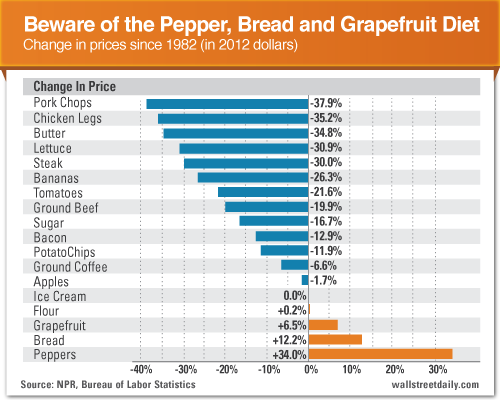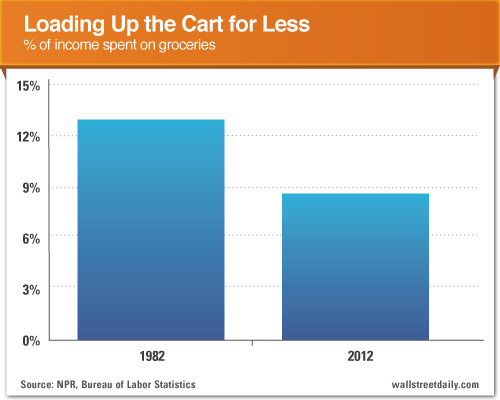Take your pick. Because they’ve all been used to characterize price trends for something we can’t live without: food.
It’s all a bunch of baloney, though. (Sorry, I couldn’t resist.)
And seeing that it’s Myth-Busting Monday – the one day of the week we dedicate to challenging Wall Street and the world’s most cherished conventional wisdom – I’m going to prove it to you, too.
So let’s get to it…
Stop Pounding the Inflation Drum, Already!
Forget months. For years, we’ve been told that the ultimate consequence of Fed Chairman Ben Bernanke’s out-of-control money printing is going to be nasty inflation.
Well, I’m still waiting!
The latest Consumer Price Index (CPI) reading actually fell 0.2% in March.
Of course, everyday Americans don’t pay attention to CPI. I’m sure countless people would say that it must be a spin-off of CBS’ wildly popular CSI series. (Go ahead. Ask someone on the street.)
One thing Americans do pay attention to, though, is the final tally at the grocery store checkout.
At the first hint of an increase, their minds immediately associate it with the inflation that we’ve been warned to expect – over and over and over again.
And those fears are only emboldened when we hear perfectly intelligent people make misleading comments.
Like Nick Colas, Chief Market Strategist at ConvergEx Group. He says, “The things that people most commonly shop for are increasing in price much more quickly than that CPI basket inflation number we’re used to seeing.”
As evidence, he points to the recent spike in lettuce and apple prices by 24% and 11%, respectively.
Come on, Nick! That’s not the whole truth, and you know it.
While certain food prices might be rising right now, that’s only a snapshot in time.
Ultimately, his analysis ignores a trend that’s been playing out for decades.
The Real Story About Food Prices in America
You see, when we go back 30 years, food prices are actually going down, not up. That is, unless you’re on some super-specialized vegetarian diet and only eat peppers and grapefruit. (See below.)
Now, let’s change our focus from the cost of individual food items to the total amount of money the average American spends on groceries.
You guessed it. It’s going down, too.
In the early 1950s, the average American spent roughly 20% of their income on groceries.
In 1982, they spent roughly 13%.
And last year, they spent less than 9%.
Plus, if we back out the amount of food we waste – roughly $1.07 per day, according to research found in the journal Food Policy – that number would be less than 8%.
The decline certainly doesn’t come from Americans eating less, either. (Just check the latest obesity statistics for proof.)
In reality, on a percentage of income basis, we actually spend less on food than any other country in the world. The French spend twice as much, while people in India spend four times as much.
How can that possibly be? Technology, baby!
As Walter Falcon, a Stanford economist who specializes in the food industry, told NPR, “We’ve seen major restructuring in [the] poultry, pork and beef industries that has allowed efficiencies and brought down the cost.”
Or, as Dr. Mark Perry of American Enterprise Institute points out, new machines and technology have made it much cheaper to produce food.
For example, a single Herr potato chip factory in Pennsylvania can now produce five to six tons of potato chips per hour. In the 1940s, it could only produce five to 10 pounds per hour.
Bottom line: When we’ve been told ad nauseam that inflation is imminent, it’s only natural for us to interpret any increase at the grocery store as a shocking indicator that it’s finally arrived.
Original post
- English (UK)
- English (India)
- English (Canada)
- English (Australia)
- English (South Africa)
- English (Philippines)
- English (Nigeria)
- Deutsch
- Español (España)
- Español (México)
- Français
- Italiano
- Nederlands
- Português (Portugal)
- Polski
- Português (Brasil)
- Русский
- Türkçe
- العربية
- Ελληνικά
- Svenska
- Suomi
- עברית
- 日本語
- 한국어
- 简体中文
- 繁體中文
- Bahasa Indonesia
- Bahasa Melayu
- ไทย
- Tiếng Việt
- हिंदी
Debunking The Food Inflation Myth In Two Charts
Published 04/22/2013, 02:56 AM
Updated 05/14/2017, 06:45 AM
Debunking The Food Inflation Myth In Two Charts
Skyrocketing. Surging. Spiking.
Latest comments
Loading next article…
Install Our App
Risk Disclosure: Trading in financial instruments and/or cryptocurrencies involves high risks including the risk of losing some, or all, of your investment amount, and may not be suitable for all investors. Prices of cryptocurrencies are extremely volatile and may be affected by external factors such as financial, regulatory or political events. Trading on margin increases the financial risks.
Before deciding to trade in financial instrument or cryptocurrencies you should be fully informed of the risks and costs associated with trading the financial markets, carefully consider your investment objectives, level of experience, and risk appetite, and seek professional advice where needed.
Fusion Media would like to remind you that the data contained in this website is not necessarily real-time nor accurate. The data and prices on the website are not necessarily provided by any market or exchange, but may be provided by market makers, and so prices may not be accurate and may differ from the actual price at any given market, meaning prices are indicative and not appropriate for trading purposes. Fusion Media and any provider of the data contained in this website will not accept liability for any loss or damage as a result of your trading, or your reliance on the information contained within this website.
It is prohibited to use, store, reproduce, display, modify, transmit or distribute the data contained in this website without the explicit prior written permission of Fusion Media and/or the data provider. All intellectual property rights are reserved by the providers and/or the exchange providing the data contained in this website.
Fusion Media may be compensated by the advertisers that appear on the website, based on your interaction with the advertisements or advertisers.
Before deciding to trade in financial instrument or cryptocurrencies you should be fully informed of the risks and costs associated with trading the financial markets, carefully consider your investment objectives, level of experience, and risk appetite, and seek professional advice where needed.
Fusion Media would like to remind you that the data contained in this website is not necessarily real-time nor accurate. The data and prices on the website are not necessarily provided by any market or exchange, but may be provided by market makers, and so prices may not be accurate and may differ from the actual price at any given market, meaning prices are indicative and not appropriate for trading purposes. Fusion Media and any provider of the data contained in this website will not accept liability for any loss or damage as a result of your trading, or your reliance on the information contained within this website.
It is prohibited to use, store, reproduce, display, modify, transmit or distribute the data contained in this website without the explicit prior written permission of Fusion Media and/or the data provider. All intellectual property rights are reserved by the providers and/or the exchange providing the data contained in this website.
Fusion Media may be compensated by the advertisers that appear on the website, based on your interaction with the advertisements or advertisers.
© 2007-2025 - Fusion Media Limited. All Rights Reserved.
